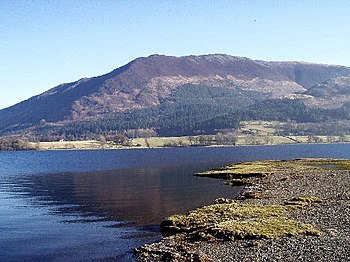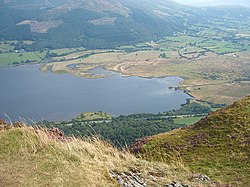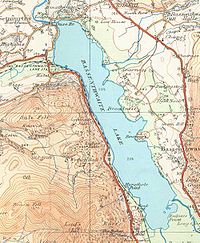Bassenthwaite Lake: Difference between revisions
Created page with 'right|thumb|350px|Bassenthwaite Lake from Blackstock Point [[File:Bassenthwaite Lake south end.jpg|right|thumb|250px|The southern end of the lake]…' |
No edit summary |
||
| Line 8: | Line 8: | ||
The A66 dual carriageway runs roughly north/south along the western side of the lake. The lay-bys are popular spots for photographers and bird watchers looking for osprey. The section running south towards Keswick was built along the course of the former Cockermouth, Keswick and Penrith railway line. | The A66 dual carriageway runs roughly north/south along the western side of the lake. The lay-bys are popular spots for photographers and bird watchers looking for osprey. The section running south towards Keswick was built along the course of the former Cockermouth, Keswick and Penrith railway line. | ||
Like the other Lake District lakes, Bassenthwaite Lake lies in a glacially | Like the other Lake District lakes, Bassenthwaite Lake lies in a glacially eroded valley, left after the last glaciation. Bassenthwaite Lake is linked to [[Derwent Water]] by the River Derwent, which crosses the 3-mile alluvial plain between the two lakes. There has been speculation that Derwent Water and Bassenthwaite Lake were once one larger lake with the alluvial flats now separating them formed from partial infill of the original basin. | ||
==Name== | ==Name== | ||
| Line 31: | Line 31: | ||
==Outside links== | ==Outside links== | ||
{{county|Cumberland}} | |||
*Location map: {{wmap|54.65|-3.217|zoom=14}} | |||
*[http://www.bassenthwaite-lake.co.uk/default.asp?textpage=home&mainnav=home&bg=048ec5 Bassenthwaite Restoration Project] | *[http://www.bassenthwaite-lake.co.uk/default.asp?textpage=home&mainnav=home&bg=048ec5 Bassenthwaite Restoration Project] | ||
*[http://www.bassenthwaite-sc.org.uk/ Bassenthwaite Sailing Club] | *[http://www.bassenthwaite-sc.org.uk/ Bassenthwaite Sailing Club] | ||
| Line 40: | Line 42: | ||
{{Reflist}} | {{Reflist}} | ||
*A Topographical Dictionary of England (1848) | *A Topographical Dictionary of England (1848) | ||
{{Lake District lakes}} | {{Lake District lakes}} | ||
[[Category:Lakes of Cumberland]] | [[Category:Lakes of Cumberland]] | ||
Revision as of 14:32, 8 January 2016



Bassenthwaite Lake in Cumberland is one of the largest lakes in the Lake District. It is long and narrow, approximately 4 miles long and ¾ mile wide, but is also very shallow, with a maximum depth of about 70 feet.
The lake lies at the foot of Skiddaw, near the town of Keswick. It is fed by, and drains into, the River Derwent.
The A66 dual carriageway runs roughly north/south along the western side of the lake. The lay-bys are popular spots for photographers and bird watchers looking for osprey. The section running south towards Keswick was built along the course of the former Cockermouth, Keswick and Penrith railway line.
Like the other Lake District lakes, Bassenthwaite Lake lies in a glacially eroded valley, left after the last glaciation. Bassenthwaite Lake is linked to Derwent Water by the River Derwent, which crosses the 3-mile alluvial plain between the two lakes. There has been speculation that Derwent Water and Bassenthwaite Lake were once one larger lake with the alluvial flats now separating them formed from partial infill of the original basin.
Name
Bassenthwaite Lake is the only body of water in the Lake District to be named a "lake" as all the others are water or mere or tarn.
Some maps dating from the 18th century mark this lake with the name Bassenwater, and the use of the name Broadwater for this lake is also attested.
Biodiversity
The lake's catchment is the largest of any lake in the Lake District. This, along with a large percentage of cultivable land within this drainage area, makes Bassenthwaite Lake a fertile habitat.
The lake contains salmon, trout, pike, perch, minnow, dace, ruffe and eel, though the predominant species is roach, which is believed to have been introduced in the form of discarded live-baits by visiting pike anglers. Also present was the vendace, until it was declared extinct within the lake in 2001. Cormorants have been known to fish the lake and herons can also be seen; at the turn of the 19th century there was a report of 60 nests in a heronry in nearby Wythop Woods. In 2001, ospreys returned to nest by the lake, and have done so regularly since.
Threats
The lake currently faces problems, which the Bassenthwaite Lake Restoration Programme[1][2] is trying to address. These include erosion, pollution (especially phosphates, which encourage algae formation)[1] and a number of alien types of flora, which are threatening to have an adverse effect on local species.
The Environment Agency attributed unacceptable levels of phosphate in the catchment to Keswick wastewater treatment works, Greta Grove pumping station and the associated overflow.[3]
Water company United Utilities was fined £27,000 in 2011 for allowing raw sewage to pollute nearby Pow Beck watercourse.[4] The company's £20 million sewer improvement scheme, begun in 2011, aims to improve water quality in the River Greta[5] and the lake itself.[6] The project will facilitate removal of greater quantities of phosphates.[7] Works to upgrade the wastewater treatment works and pumping station were begun in May 2010.[3]
Neolithic man
It has been reported that the wide gravel spreads between Derwent Water and Bassenthwaite Lake provided the best centre within Lakeland for Neolithic farming communities. Stone axes have been found in the area and particularly at Mossgarth, Portinscale.
Outside links
- Location map: 54°39’-0"N, 3°13’1"W
- Bassenthwaite Restoration Project
- Bassenthwaite Sailing Club
- Lake District Osprey Project
- Parliamentary questions and answers on pollution in the Lake
- Cockermouth, Keswick & Penrith Historic Rail Line
References
- ↑ 1.0 1.1 Lewes, Martin (May 17, 2010). "Progress in campaign to reduce Lake District pollution". BBC News. http://news.bbc.co.uk/local/cumbria/hi/people_and_places/nature/newsid_8686000/8686512.stm. Retrieved February 15, 2012. "The Bassenthwaite Lake Restoration Project is now reaching its first decade [...] Phosphates enrich the water, with the most visible result being blooms of algae [...]"
- ↑ "River Basin Management Plan North West River Basin District". Water for life and livelihoods. Environment Agency. December 2009. p. 76. http://publications.environment-agency.gov.uk/PDF/GENW0910BSRG-E-E.pdf. Retrieved February 15, 2012. "the Environment Agency will work with partners to improve lakes, meres and reservoirs through: Implementing the actions of the five-year programme for the Bassenthwaite Lake Restoration programme and Windermere Catchment Restoration Programme [...]"
- ↑ 3.0 3.1 "Wastewater scheme will help restore lake". Cumberland and Westmorland Herald. October 15, 2010. http://www.cwherald.com/archive/archive/wastewater-scheme--will-help-restore-lake-20101015359373.htm. Retrieved February 15, 2012. "Keswick wastewater treatment works, Greta Grove pumping station and the associated overflow have been identified by the Environment Agency as having contributed to unacceptable levels of phosphate in the Bassenthwaite Lake catchment. In May, United Utilities began work on the scheme to upgrade the wastewater treatment works and resolve the problem of the Greta Grove pumping station."
- ↑ "United Utilities fined £27,000 for Keswick sewage leaks". BBC News. November 25, 2011. http://www.bbc.co.uk/news/uk-england-cumbria-15888597. Retrieved February 15, 2012. "[...] two leaks into the Pow Beck watercourse in Keswick [...]"
- ↑ "Keswick project overview". United Utilities. http://capitalprogrammes.unitedutilities.com/lakedistrict/bassenthwaitelakeimprove.aspx. Retrieved February 15, 2012. "[...] designed to improve the quality of water in the River Greta and Bassenthwaite Lake."
- ↑ "Keswick's £23m sewer revamp gets under way". BBC News. September 19, 2011. http://www.bbc.co.uk/news/uk-england-cumbria-14976958. Retrieved February 15, 2012. "The United Utilities project aims to improve the public network, lessen the risk of flooding, and improve water quality of Bassenthwaite Lake."
- ↑ "£20m Keswick pollution project to benefit lake". Cumberland News. August 26, 2011. http://www.cumberlandnews.co.uk/news/going-green/20m-keswick-pollution-project-to-benefit-lake-1.872188. Retrieved February 15, 2012. "[...] allowing it to treat larger amounts of water and remove greater quantities of dangerous phosphates."
- A Topographical Dictionary of England (1848)
| Major waters of the Lake District | ||
|---|---|---|
| Cumberland: | Bassenthwaite Lake • Burnmoor Tarn • Buttermere • Cogra Moss • Crummock Water • Derwent Water • Devoke Water • Ennerdale Water • Loweswater • Thirlmere • Wast Water | |
| Cumb. / Westm.: | Ullswater | |
| Westmorland: | Grasmere • Haweswater • Rydal Water | |
| Lancs. / Westm.: | Windermere • Elter Water | |
| Lancashire: | Coniston Water • Esthwaite Water • Seathwaite Tarn • Tarn Hows | |